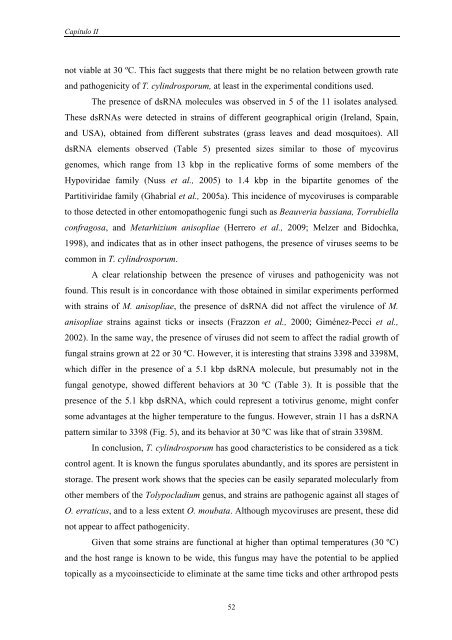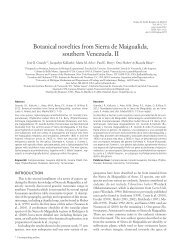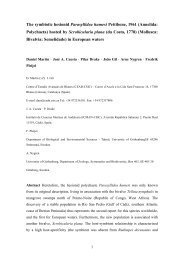TESIS NOEMI HERRERO.pdf - Consejo Superior de Investigaciones ...
TESIS NOEMI HERRERO.pdf - Consejo Superior de Investigaciones ...
TESIS NOEMI HERRERO.pdf - Consejo Superior de Investigaciones ...
Create successful ePaper yourself
Turn your PDF publications into a flip-book with our unique Google optimized e-Paper software.
Capítulo II<br />
not viable at 30 ºC. This fact suggests that there might be no relation between growth rate<br />
and pathogenicity of T. cylindrosporum, at least in the experimental conditions used.<br />
The presence of dsRNA molecules was observed in 5 of the 11 isolates analysed.<br />
These dsRNAs were <strong>de</strong>tected in strains of different geographical origin (Ireland, Spain,<br />
and USA), obtained from different substrates (grass leaves and <strong>de</strong>ad mosquitoes). All<br />
dsRNA elements observed (Table 5) presented sizes similar to those of mycovirus<br />
genomes, which range from 13 kbp in the replicative forms of some members of the<br />
Hypoviridae family (Nuss et al., 2005) to 1.4 kbp in the bipartite genomes of the<br />
Partitiviridae family (Ghabrial et al., 2005a). This inci<strong>de</strong>nce of mycoviruses is comparable<br />
to those <strong>de</strong>tected in other entomopathogenic fungi such as Beauveria bassiana, Torrubiella<br />
confragosa, and Metarhizium anisopliae (Herrero et al., 2009; Melzer and Bidochka,<br />
1998), and indicates that as in other insect pathogens, the presence of viruses seems to be<br />
common in T. cylindrosporum.<br />
A clear relationship between the presence of viruses and pathogenicity was not<br />
found. This result is in concordance with those obtained in similar experiments performed<br />
with strains of M. anisopliae, the presence of dsRNA did not affect the virulence of M.<br />
anisopliae strains against ticks or insects (Frazzon et al., 2000; Giménez-Pecci et al.,<br />
2002). In the same way, the presence of viruses did not seem to affect the radial growth of<br />
fungal strains grown at 22 or 30 ºC. However, it is interesting that strains 3398 and 3398M,<br />
which differ in the presence of a 5.1 kbp dsRNA molecule, but presumably not in the<br />
fungal genotype, showed different behaviors at 30 ºC (Table 3). It is possible that the<br />
presence of the 5.1 kbp dsRNA, which could represent a totivirus genome, might confer<br />
some advantages at the higher temperature to the fungus. However, strain 11 has a dsRNA<br />
pattern similar to 3398 (Fig. 5), and its behavior at 30 ºC was like that of strain 3398M.<br />
In conclusion, T. cylindrosporum has good characteristics to be consi<strong>de</strong>red as a tick<br />
control agent. It is known the fungus sporulates abundantly, and its spores are persistent in<br />
storage. The present work shows that the species can be easily separated molecularly from<br />
other members of the Tolypocladium genus, and strains are pathogenic against all stages of<br />
O. erraticus, and to a less extent O. moubata. Although mycoviruses are present, these did<br />
not appear to affect pathogenicity.<br />
Given that some strains are functional at higher than optimal temperatures (30 ºC)<br />
and the host range is known to be wi<strong>de</strong>, this fungus may have the potential to be applied<br />
topically as a mycoinsectici<strong>de</strong> to eliminate at the same time ticks and other arthropod pests<br />
52

















